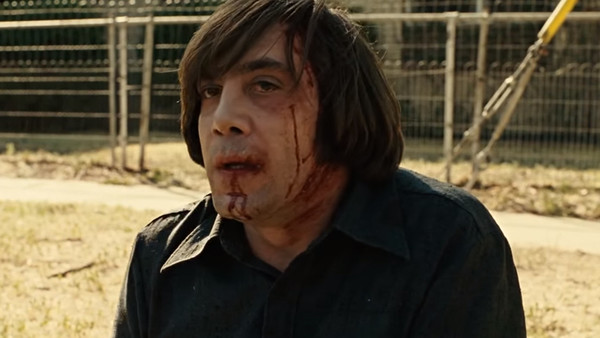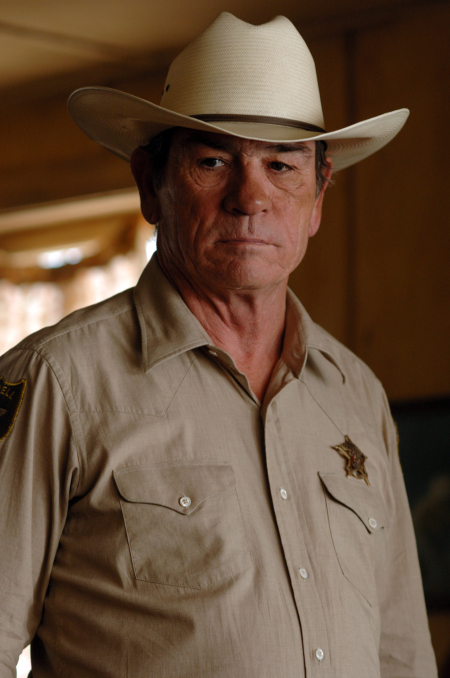No Country for old men - Opening Scene Analysis
 Meeting Anton Chigurh for the first time
Meeting Anton Chigurh for the first time
The Police officer guides his culprit in handcuffs towards the car, ensuring we cannot see his face. The door opens and we receive a close up of the culprits rather modern weapon- a cattle gun. This can be contrasted with the Sheriff's old school weapon. Through use of a mid-shot, we see the police man sitting in the front seat, lit with beautiful natural warm toned lighting. Sitting behind him off-centred is the criminal. He is lit very darkly, with only his frame in the shadows to be seen. Evidently, we are definitely not aligned with him. The police car bolts by whilst the camera slowly pans upwards as Sheriff Bell finishes his monologue.
In the next cut, the officer is on the phone discussing the arrest with a very nonchalant attitude. Once again, the officer is framed in the centre and our mysterious criminal is sitting behind, not even in focus. The camera begins slowly panning towards the officer as he stands up, still out of focus. He walks up behind the officer and just as he assures the sheriff "yes sir, I got it under control", Chigurh wraps the handcuffs around the officers neck. The two characters can be contrasted starkly by comparing their costumes. The officer is dressed in his beige uniform, clearly fitting into the western landscape and genre whereas Chigurh is displayed in all Black. He looks as if he's come straight out of horror film, with only his red cowboy boots linking him to this genre. There is a brief struggle for a few shots as Chigurh strangles his victim. We receive various angles and shot types until the camera begins slowly panning both clockwise and anti-clockwise, lingering on a close-up of chigurh briefly. There is no non-diegetic music, the only noise to be heard is the squeaky sound of boots kicking off the floor. Soon, blood begins spewing from the officers neck as the kicking and squirming comes to a halt. Chigurh, along with his modern weapon can be seen to represent the new wave of crime presenting one of the main themes from very early on.
The next shot is set at a sink, with Chigurh washing the blood off of his hands. Typically, a shot by the sink would have the character framed standing in-front of the mirror and the camera positioned behind them, allowing the audience to see the characters face. However, this scene is shot at a higher angle, looking down at the sink with only Chigurh's hands reflecting the image in the mirror from above. This, once again actively avoids alignment with this character.
Meeting Lewellyn Moss for the first time
The Cowboy
 It is important to note the very last cut before this scene was of Chigurh asking a man he pulled over to "please hold still" before proceeding to shoot him clean through the head like an animal with his cattle gun. The scene cuts to a point of view shot looking through Lewllyn's rifle whilst he is out hunting which straightaway aligns us with him. The mise-en-scene is blatantly western; nothing but desert for miles. There is an extreme close-up of his face and an extreme long shot of the landscape as he murmurs "hold still", mirroring Chigurh's lines from the previous scene. Subsequently, this creates expectations for the audience for these two characters to eventually meet at some point down the line.
It is important to note the very last cut before this scene was of Chigurh asking a man he pulled over to "please hold still" before proceeding to shoot him clean through the head like an animal with his cattle gun. The scene cuts to a point of view shot looking through Lewllyn's rifle whilst he is out hunting which straightaway aligns us with him. The mise-en-scene is blatantly western; nothing but desert for miles. There is an extreme close-up of his face and an extreme long shot of the landscape as he murmurs "hold still", mirroring Chigurh's lines from the previous scene. Subsequently, this creates expectations for the audience for these two characters to eventually meet at some point down the line.
No Country for Old Men explores alignment and allegiance in depth, and even uses elements of film form to actively avoid alignment with one of our protagonists in the opening scene. The film also heavily encourages active spectatorship in many aspects, more prominently towards the end of the film, but subtly encourages this from the very beginning. Furthermore, in the opening scenes, some of the core themes are introduced such as the changing nature of crime, order versus chaos, past versus future and good versus evil. This is all done through very thorough and elegant use of film form and characterisation.
The sheriff
 |
Alignment with Sheriff Tom Ed Bell
We are first introduced to Sheriff Ed Tom Bell audibly. Although we don't actually see him, Sheriff Bell is displayed through the most blatant form of alignment- voiceover. He claims "my grandfather was a lawman...father too". He goes on to say "some of the old-time Sheriffs never even wore a gun. A lot of folks find that hard to believe", introducing one of the film's key themes: the changing nature of crime. He continues "I don't know what to make of that. I sure as hell don't...". Straightaway, from the very first scene of the film, the monologue functions in characterising Sheriff Tom Ed Bell; He's an old-timer, set in his old-timer ways. He doesn't understand modern crime- "the crime you see now, it's hard to even take it's measure. It's not that i'm afraid of it, i always knew you had to be willing to die to even do this job. But I don't wanna push my chips forward and go out and meet something I don't understand", clearly representing the past. Personally, I view this open monologue to seal Sheriff Bell's fate and his role in the outcome of the ending as it sets the underlying bleak tones which become more prominent as the film progresses. As Sheriff Bell delivers his monologue, warm-toned shots from a typical western landscape appear. They transition from being completely natural and open landscapes, then slowly shift towards modern civilisation, introducing man-made fences and wind-mills into the shots until finally, a panning shot from right to left resting on a police car. A policeman and his culprit enter the scene.
In terms of alignment, it is crucial to note we are immediately forced to align with Sheriff Bell, in contrast to our next protagonist we meet.
The Hired Gun

The Police officer guides his culprit in handcuffs towards the car, ensuring we cannot see his face. The door opens and we receive a close up of the culprits rather modern weapon- a cattle gun. This can be contrasted with the Sheriff's old school weapon. Through use of a mid-shot, we see the police man sitting in the front seat, lit with beautiful natural warm toned lighting. Sitting behind him off-centred is the criminal. He is lit very darkly, with only his frame in the shadows to be seen. Evidently, we are definitely not aligned with him. The police car bolts by whilst the camera slowly pans upwards as Sheriff Bell finishes his monologue.
In the next cut, the officer is on the phone discussing the arrest with a very nonchalant attitude. Once again, the officer is framed in the centre and our mysterious criminal is sitting behind, not even in focus. The camera begins slowly panning towards the officer as he stands up, still out of focus. He walks up behind the officer and just as he assures the sheriff "yes sir, I got it under control", Chigurh wraps the handcuffs around the officers neck. The two characters can be contrasted starkly by comparing their costumes. The officer is dressed in his beige uniform, clearly fitting into the western landscape and genre whereas Chigurh is displayed in all Black. He looks as if he's come straight out of horror film, with only his red cowboy boots linking him to this genre. There is a brief struggle for a few shots as Chigurh strangles his victim. We receive various angles and shot types until the camera begins slowly panning both clockwise and anti-clockwise, lingering on a close-up of chigurh briefly. There is no non-diegetic music, the only noise to be heard is the squeaky sound of boots kicking off the floor. Soon, blood begins spewing from the officers neck as the kicking and squirming comes to a halt. Chigurh, along with his modern weapon can be seen to represent the new wave of crime presenting one of the main themes from very early on.
The next shot is set at a sink, with Chigurh washing the blood off of his hands. Typically, a shot by the sink would have the character framed standing in-front of the mirror and the camera positioned behind them, allowing the audience to see the characters face. However, this scene is shot at a higher angle, looking down at the sink with only Chigurh's hands reflecting the image in the mirror from above. This, once again actively avoids alignment with this character.
Meeting Lewellyn Moss for the first time
The Cowboy
 It is important to note the very last cut before this scene was of Chigurh asking a man he pulled over to "please hold still" before proceeding to shoot him clean through the head like an animal with his cattle gun. The scene cuts to a point of view shot looking through Lewllyn's rifle whilst he is out hunting which straightaway aligns us with him. The mise-en-scene is blatantly western; nothing but desert for miles. There is an extreme close-up of his face and an extreme long shot of the landscape as he murmurs "hold still", mirroring Chigurh's lines from the previous scene. Subsequently, this creates expectations for the audience for these two characters to eventually meet at some point down the line.
It is important to note the very last cut before this scene was of Chigurh asking a man he pulled over to "please hold still" before proceeding to shoot him clean through the head like an animal with his cattle gun. The scene cuts to a point of view shot looking through Lewllyn's rifle whilst he is out hunting which straightaway aligns us with him. The mise-en-scene is blatantly western; nothing but desert for miles. There is an extreme close-up of his face and an extreme long shot of the landscape as he murmurs "hold still", mirroring Chigurh's lines from the previous scene. Subsequently, this creates expectations for the audience for these two characters to eventually meet at some point down the line.
After he takes the shot and misses, we can see our character's costume through use of a mid-shot. He has the typical western iconography: the cowboy hat, the cowboy boots and the cowboy plaid shirt. He's even got the moustache. he's displayed in warm toned colours like cream and orange as opposed to Chigurh who is dressed head to toe in black. From this we can gather There is another extreme close-up of the landscape using a still shot as Lewellyn begins to walk across.
Throughout all encounters with these characters, there is no non-diegetic music used which is an element of film form consistently missing in the film. This is quite typical of the Coen brothers and it adds a certain level of authenticity to the film and makes it feel more realistic.
Throughout all encounters with these characters, there is no non-diegetic music used which is an element of film form consistently missing in the film. This is quite typical of the Coen brothers and it adds a certain level of authenticity to the film and makes it feel more realistic.
Comments
Post a Comment